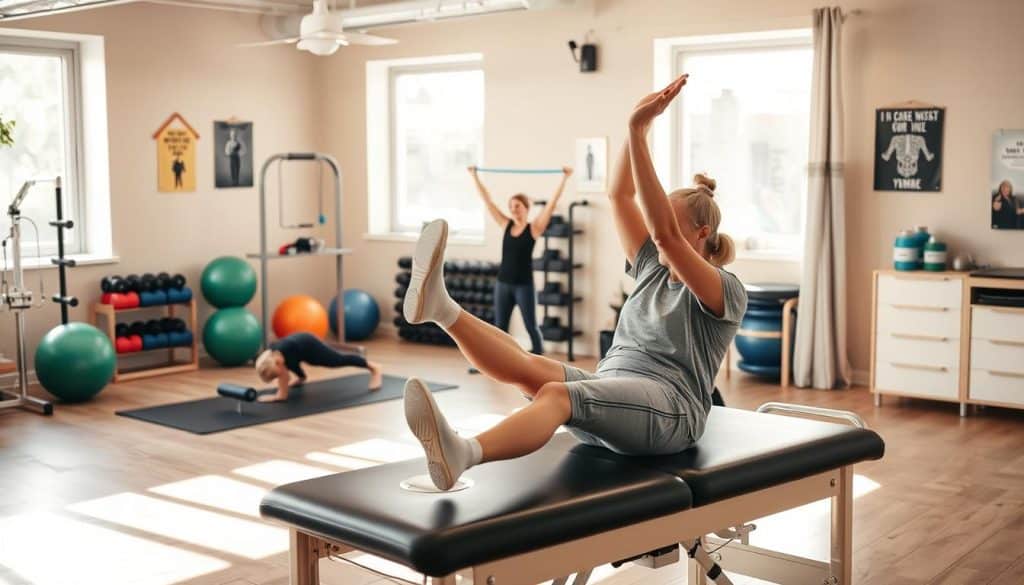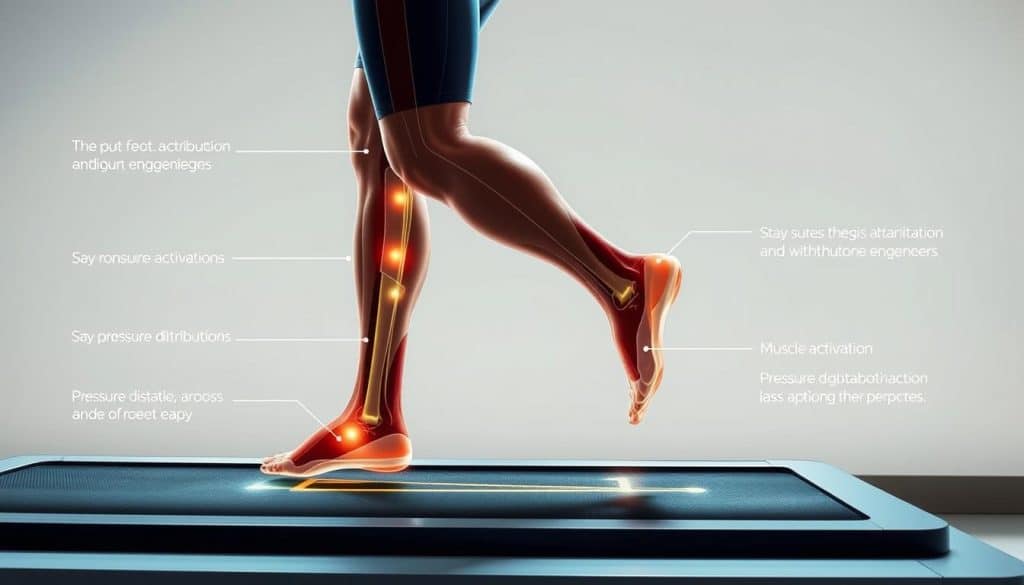Did you know that effective communication between healthcare providers and patients is crucial for successful rehabilitation? At Riverside Sports Therapy in Calgary, AB, Canada, we understand the importance of clear understanding in the recovery process.
Combining principles from physiotherapy and exercise science, our sports therapy services help athletes and active individuals recover from injuries, improve performance, and prevent future problems. Understanding the language used by our therapists is essential for patients to fully engage with their treatment plans.
To bridge this communication gap, we’ve compiled a comprehensive glossary of terms used in our practice, covering anatomical structures, movement patterns, assessment techniques, and treatment modalities.
Key Takeaways
- Understanding sports therapy terminology empowers patients to take an active role in their recovery.
- Clear communication between therapists and patients ensures better treatment outcomes.
- Riverside Sports Therapy in Calgary provides comprehensive rehabilitation services.
- Our glossary covers a wide range of terms used in sports therapy practice.
- Educated patients achieve better outcomes and improved overall well-being.
Understanding Sports Therapy Terminology
The language of sports therapy is complex, drawing from multiple disciplines to describe the body’s response to injury and treatment. Sports therapy terminology encompasses a wide range of terms from orthopedic and neurologic specialties. Understanding these terms helps patients better engage with their treatment plans and communicate effectively with their therapists.
Sports therapy terminology draws from anatomy, physiology, biomechanics, and exercise science, creating a specialized vocabulary. This vocabulary describes how the body moves, functions, and responds to treatment. For instance, terms related to pain patterns, tissue healing processes, and movement mechanics are commonly used.
Learning key terms helps patients better understand their conditions, treatment options, and home exercise programs. This understanding leads to improved outcomes and more effective rehabilitation at Riverside Sports Therapy in Calgary, AB, Canada. Patients can contact us at (403)283-7551 for more information.
Understanding the difference between orthopedic terms and neurologic terms provides context for how different body systems interact during injury and recovery. Orthopedic terms relate to the musculoskeletal system, while neurologic terms relate to the nervous system.
As a leading sports therapy clinic, Riverside Sports Therapy takes the time to explain terminology in accessible ways. “Empowering patients with knowledge is key to successful rehabilitation,” says one of our experienced therapists. Familiarity with sports therapy terminology empowers patients to ask informed questions, follow treatment protocols accurately, and take ownership of their rehabilitation journey.
- Key terms help patients understand their conditions and treatment options.
- Understanding sports therapy terminology improves communication between patients and therapists.
- Effective rehabilitation relies on patients being informed about their treatment plans.
Anatomical Terms and Body Structures
Anatomical knowledge forms the foundation of sports therapy, enabling therapists to assess and treat injuries accurately. Understanding the complex structures of the human body is essential for effective treatment and rehabilitation.
Bones and Joints
The skeletal system, comprising bones and joints, provides the structural framework for the body. Bones serve as attachment points for muscles and tendons, while joints facilitate movement and flexibility. Understanding the anatomy of bones and joints is critical in sports therapy, as injuries to these areas are common among athletes.
At Riverside Sports Therapy in Calgary, therapists assess and treat various bone and joint injuries, utilizing techniques to alleviate pain and restore function. Accurate diagnosis and treatment planning rely heavily on a thorough understanding of anatomical structures.
Soft Tissues
Soft tissues, including muscles, tendons, ligaments, and fascia, play a vital role in movement and stability. These non-bony components of the musculoskeletal system work together to generate force, absorb shock, and provide proprioceptive feedback.
Soft tissue injuries, such as muscle strains and tendon inflammation, are common in sports. Effective treatment requires a comprehensive understanding of soft tissue anatomy and function. Therapists at Riverside Sports Therapy use various techniques, including palpation to detect areas of tension or abnormal tissue texture, to assess and treat soft tissue injuries, helping to alleviate pain and restore normal function under pressure.
Movement and Range of Motion Terminology
The language of movement and range of motion is fundamental in sports therapy, enabling precise assessment and treatment. Understanding these terms is essential for both therapists and patients to communicate effectively about injuries, rehabilitation exercises, and progress.
Types of Range of Motion
Range of motion refers to the extent of movement possible in a joint or series of joints. There are several types of range of motion, including active, passive, and resisted. Active range of motion is the movement achieved by contracting the muscles surrounding a joint, while passive range of motion is the movement achieved by an external force, such as a therapist or a machine, without the patient using their muscles. Resisted range of motion involves moving a joint against an external resistance.
| Type of Range of Motion | Description | Example |
|---|---|---|
| Active | Movement achieved by contracting muscles | Patient lifts their arm |
| Passive | Movement achieved by an external force | Therapist moves the patient’s arm |
| Resisted | Movement against an external resistance | Patient lifts their arm against a weight |
Movement Directions
Movement directions are specific terms used to describe how body parts move in relation to the anatomical position. These include flexion, extension, abduction, adduction, rotation, and more. For instance, flexion and extension describe movements that decrease or increase the angle between body parts. Abduction refers to movement away from the body’s midline, like raising your arm out to the side, while adduction is movement toward the midline, bringing your arm back to your side.
Other critical movement terms include pronation and supination, which describe the rotation of the forearm, and dorsiflexion and plantarflexion, which are movements at the ankle. Inversion and eversion describe movements of the foot. Understanding these directions helps patients follow exercise instructions more accurately and allows therapists to document changes in movement patterns with precision.
At Riverside Sports Therapy in Calgary, therapists analyze movement patterns to identify dysfunctional movements that may contribute to pain or injury. By using standardized terminology, therapists can communicate effectively with patients and other healthcare professionals, ensuring comprehensive care.
Muscle Function and Strengthening Terms
Understanding muscle function and strengthening terms is crucial for effective sports therapy. Muscle function refers to the ability of muscles to contract and relax, enabling movement and maintaining posture. Strengthening terms relate to the exercises and techniques used to improve muscle strength and endurance.
Muscle Contraction Types
Muscle contractions are categorized into different types based on the movement and tension generated. There are isometric contractions, where the muscle length remains constant, and isotonic contractions, where the muscle shortens or lengthens under load. Understanding these contraction types is essential for designing effective strengthening exercises.
Isometric contractions are useful for improving strength without moving the joint, while isotonic contractions are used for exercises that involve movement. Both types are crucial for a well-rounded rehabilitation program.
Strength and Conditioning Concepts
Strength and conditioning in sports therapy involve systematic approaches to improving physical performance. This includes exercises designed to enhance muscular strength, power, endurance, and neuromuscular control. Key concepts include progressive overload, specificity, and periodization.
| Concept | Description | Application |
|---|---|---|
| Progressive Overload | Gradually increasing exercise intensity | Improves muscular strength and endurance |
| Specificity | Designing exercises specific to the sport or activity | Enhances performance in specific contexts |
| Periodization | Varying training parameters over time | Optimizes performance gains and minimizes injury risk |
At Riverside Sports Therapy in Calgary, strength and conditioning programs are tailored to individual needs, considering factors such as injury history and performance goals. Core stability training is also emphasized to improve overall athletic performance and reduce injury risk.
Sports Therapy Terminology Glossary: Assessment and Diagnosis
The process of assessment and diagnosis in sports therapy involves a comprehensive evaluation of the musculoskeletal system. This phase is critical for identifying the underlying causes of pain and dysfunction, allowing therapists to develop targeted treatment plans.
Evaluation Procedures
Evaluation procedures in sports therapy are designed to assess various aspects of musculoskeletal function. These include examining the range of movement, testing muscle strength, and evaluating joint stability. Therapists also assess coordination and overall functional ability to identify any limitations or dysfunctions.
During the evaluation, therapists may use various techniques such as palpation to detect tension in the muscles, and special tests to assess the integrity of joints and surrounding soft tissues. The goal is to gather comprehensive information about the client’s condition to inform the treatment plan.
Common Findings
Common findings in sports therapy assessments include muscle imbalances, movement dysfunctions, joint restrictions, and various tissue dysfunctions that contribute to pain or limited function. For instance, muscle imbalances occur when certain muscles are overactive while their antagonists are underactive, leading to dysfunctional movement patterns.
- Movement compensations often arise due to pain, weakness, or joint restrictions, potentially leading to secondary issues.
- Joint hypomobility or hypermobility can both contribute to dysfunction, requiring different treatment approaches.
- Altered neuromuscular control can manifest as poor coordination or timing issues between muscle groups.
- Myofascial trigger points are hyperirritable spots within taut bands of muscle that can cause local tenderness and referred pain patterns.
Understanding these common findings is crucial for developing effective treatment strategies that address the root causes of dysfunction and pain, ultimately enhancing the client’s overall ability to perform daily and athletic activities.
Injury and Condition Terminology
Understanding injury and condition terminology is crucial for effective communication in sports therapy. Accurate diagnosis and treatment depend on a clear understanding of these terms.
Acute Injuries
Acute injuries occur suddenly and typically result from a specific incident or trauma. These injuries often involve immediate pain and can lead to inflammation, swelling, and reduced function. Examples include fractures, sprains, and strains. The initial response to acute injury involves the body’s natural healing processes, including increased blood flow to the affected area.
Acute injuries can vary in severity, from mild to severe, and may require immediate medical attention. Proper assessment and diagnosis are critical to determine the appropriate treatment and rehabilitation plan.
Chronic Conditions
Chronic conditions in sports therapy develop gradually over time or persist beyond the normal healing timeframe of an acute injury. These conditions often result from repetitive stress, poor biomechanics, or inadequate rehabilitation, leading to persistent pain and reduced function. Examples include tendinopathies, syndrome such as myofascial pain syndrome, and osteoarthritis.
Treatment of chronic conditions at Riverside Sports Therapy in Calgary focuses on addressing the underlying biomechanical, training, or movement factors that contributed to the condition’s development. This approach includes managing symptoms, improving tissue health, and reducing pressure on affected areas to restore optimal function.
Spine and Posture Terminology
Spine and posture terminology encompasses a range of terms that are vital for healthcare professionals to understand when assessing and treating musculoskeletal issues. The spine is a complex structure that plays a crucial role in supporting the body and facilitating movement.
Spinal Regions and Structures
The spine is divided into several regions, each with distinct anatomical features and functions. The main regions are the cervical, thoracic, lumbar, sacrum, and coccyx. Understanding the structure of the spine, including the vertebrae, discs, and ligaments, is essential for diagnosing and treating spinal-related conditions. The spine’s curvature and alignment are critical for distributing stress evenly across the body, minimizing the risk of pain and dysfunction.
The spinal regions are prone to various issues due to their complex structure and the loads they bear. For instance, the lumbar region is particularly susceptible to strain due to its weight-bearing role, often resulting in lower back pain.
| Spinal Region | Common Issues | Typical Symptoms |
|---|---|---|
| Cervical | Neck strain, herniated discs | Neck pain, radiating pain to arms |
| Thoracic | Scoliosis, kyphosis | Back pain, postural deformity |
| Lumbar | Lower back strain, disc herniation | Lower back pain, sciatica |
Posture and Alignment
Posture refers to the alignment of body segments in relation to each other and to gravity. Good posture minimizes stress on joints and muscles, while poor posture can contribute to pain and dysfunction. Postural assessment evaluates alignment from anterior, lateral, and posterior views, looking for deviations from ideal alignment.
Common postural dysfunctions include upper crossed syndrome, characterized by forward head posture and rounded shoulders, and lower crossed syndrome, marked by increased lumbar lordosis and anterior pelvic tilt. Postural retraining involves awareness training, strengthening underactive muscles, stretching or releasing overactive muscles, and integrating improved alignment into functional activities.

At Riverside Sports Therapy in Calgary, postural education and correction are integral components of treatment for many conditions, particularly those affecting the neck and lower back. By understanding and addressing postural issues, individuals can reduce their risk of pain and improve their overall bodily function.
Rehabilitation and Exercise Terminology
The language of rehabilitation and exercise is fundamental to sports therapy, facilitating precise assessment and intervention strategies. Effective rehabilitation programs rely on a comprehensive understanding of various exercise types and their progression.
Rehabilitation Concepts
Rehabilitation in sports therapy involves a systematic approach to restoring function and ability after injury or illness. It encompasses a range of exercises tailored to individual needs and goals. A key concept is the progression of exercises based on tissue healing timeframes and patient response.
At Riverside Sports Therapy in Calgary, rehabilitation programs are highly individualized, focusing on restoring strength and enhancing movement patterns. This personalized approach ensures that patients receive the most effective care.
| Rehabilitation Phase | Exercise Focus | Example Activities |
|---|---|---|
| Initial Phase | Improving range of motion and initial strength | Gentle stretching, isometric exercises |
| Progressive Phase | Enhancing stability and functional activities | Balance training, isotonic exercises, proprioceptive training |
| Advanced Phase | Functional training and activities specific to sports or daily tasks | Plyometric training, agility drills, sport-specific drills |
Exercise Types and Progression
A variety of exercises are utilized in sports therapy, including flexibility exercises, strengthening exercises, proprioceptive training, cardiovascular conditioning, and functional training. The progression of these exercises is guided by the stage of healing and the individual’s response to treatment, with the goal of restoring optimal strength and function.

The progression from one type of exercise to another is systematic, often starting with isometric exercises, moving to isotonic exercises, and eventually incorporating plyometric exercises as appropriate. This progression is crucial for ensuring stability and enhancing functional ability.
Balance, Gait, and Functional Movement Terms
The assessment of balance, gait, and functional movement patterns plays a significant role in diagnosing and treating movement dysfunctions. In sports therapy, understanding these concepts is crucial for identifying issues that may lead to pain, dysfunction, or reduced performance.
Balance and Stability
Balance refers to the ability to maintain the body’s center of gravity within its base of support. It involves complex interactions between the sensory, motor, and musculoskeletal systems. Balance and stability are critical for both daily activities and athletic performance. Factors affecting balance include proprioception, muscle strength, and neuromuscular coordination.
At Riverside Sports Therapy in Calgary, therapists assess balance using various tests and exercises that challenge the client’s stability. Corrective exercises focus on enhancing proprioception, strengthening key muscle groups, and improving overall coordination.
Gait and Movement Patterns

Functional movement patterns, such as squatting, lunging, pushing, pulling, and rotating, are essential for both daily activities and athletic movements. Therapists at Riverside Sports Therapy analyze these patterns to identify dysfunctions and implement corrective exercises to restore optimal movement.
Treatment Techniques and Modalities
In sports therapy, the judicious use of treatment techniques and modalities can significantly impact patient outcomes. Effective treatment plans often combine various approaches to address the specific needs of each patient.
Manual Therapy Techniques
Manual therapy techniques involve hands-on methods to promote healing, reduce pain, and improve function. These techniques can include massage, joint mobilization, and soft tissue mobilization. By applying specific manual therapy techniques, therapists can reduce muscle tension, improve blood flow, and enhance the overall recovery process.
For instance, a therapist might use a particular technique to increase joint mobility or reduce scar tissue formation. The choice of manual therapy technique depends on the patient’s condition, the stage of healing, and the therapist’s professional judgment.

Physical Modalities
Physical modalities are adjunctive treatments that utilize various forms of energy or agents to produce physiological effects. These modalities can facilitate healing, manage pain, or prepare tissues for exercise or manual therapy. Common physical modalities include therapeutic ultrasound, electrical stimulation, heat, and cold therapy.
| Modality | Purpose | Effect |
|---|---|---|
| Therapeutic Ultrasound | Accelerate healing, improve tissue extensibility | Thermal and non-thermal effects on tissues |
| Electrical Stimulation | Pain modulation, muscle re-education | Stimulates muscle contraction, reduces pain |
| Thermotherapy (Heat) | Relax muscles, increase blood flow | Increases tissue extensibility, reduces muscle tension |
| Cryotherapy (Cold) | Reduce inflammation, numb pain | Decreases blood flow, reduces metabolic rate |
At Riverside Sports Therapy, these modalities are used selectively as part of a comprehensive treatment approach. The goal is to facilitate active rehabilitation rather than creating passive dependency on the treatment. By carefully selecting and applying physical modalities, therapists can enhance the recovery process and improve patient outcomes.
Post-Surgical and Recovery Terminology
Understanding post-surgical and recovery terminology is essential for effective rehabilitation and optimal patient outcomes. Post-surgical care involves a range of terminology that healthcare professionals must be familiar with to provide comprehensive care.
Surgical Precautions
Surgical precautions are critical in the early stages of recovery, focusing on minimizing the risk of complications and promoting a smooth rehabilitation process. These precautions often include avoiding certain activities that could strain the affected area, managing pain effectively, and monitoring for signs of infection or other complications.
Patients are often advised on the proper use of assistive devices and post-operative instructions to ensure they don’t compromise their recovery. Proper care during this phase is crucial for achieving the best possible outcome.
Recovery Milestones
Recovery milestones are specific achievements that indicate progress through the rehabilitation process. These milestones can include achieving certain ranges of motion, strength levels, or functional abilities. Early phase milestones typically focus on pain control, wound healing, and basic activities such as transfers or ambulation.
- Achieving minimum strength thresholds, often measured as a percentage of the uninvolved side.
- Normalized gait patterns and improved balance.
- Return to basic daily activities and eventually to sport-specific or activity-specific functions.
The use of functional testing provides objective measures of recovery and readiness for progression. At Riverside Sports Therapy, these milestones are individualized based on the specific surgery or injury, patient goals, and evidence-based protocols.
Specialized Sports Therapy Approaches
The field of sports therapy has evolved to include specialized approaches that cater to the unique needs of athletes across different sports and activities. These advanced techniques are designed to enhance athletic performance, prevent injuries, and facilitate recovery.
Neurological Approaches
Neurological approaches in sports therapy focus on the motor system and its role in movement and injury. Techniques such as neuromuscular re-education help restore normal motor patterns and strength after injury. This approach is crucial for athletes who require precise motor control for their sport. By enhancing the communication between the nervous system and muscles, therapists can help athletes regain optimal function and reduce the risk of re-injury.
For instance, neurological rehabilitation may involve exercises that challenge the athlete’s balance and proprioception, thereby improving overall motor function. The goal is to ensure that the athlete’s motor system is fully rehabilitated before returning to sport.
Sport-Specific Rehabilitation
Sport-specific rehabilitation tailors treatment to the demands of particular sports, addressing the unique movement patterns, physical requirements, and injury risks associated with different athletic activities. This approach bridges the gap between general rehabilitation and return to sport by systematically addressing the unique physical, technical, and psychological demands of a particular sport or activity.
- Movement analysis of sport-specific techniques allows therapists to identify the biomechanical requirements and potential injury mechanisms.
- Energy system training ensures that athletes develop the appropriate metabolic conditioning for their sport.
- Return-to-sport testing uses standardized protocols to objectively assess an athlete’s readiness to resume training and competition.
At Riverside Sports Therapy, therapists work with athletes of all levels to develop sport-specific rehabilitation programs that consider not only the physical demands but also the psychological aspects of returning to sport after injury.
Conclusion: Applying Your Sports Therapy Knowledge
With a solid grasp of sports therapy terminology, you’re empowered to take an active role in your recovery journey. This glossary has provided you with a comprehensive understanding of the terms used by your therapist at Riverside Sports Therapy in Calgary. You can now better understand your condition, treatment options, and home exercise program, allowing for more effective communication and better adherence to your treatment plan.
For personalized sports therapy care, contact Riverside Sports Therapy at (403)283-7551 to schedule an assessment. By applying your knowledge of sports therapy terminology, you can ask informed questions and deepen your understanding of your rehabilitation process, ultimately enhancing your care and recovery.
